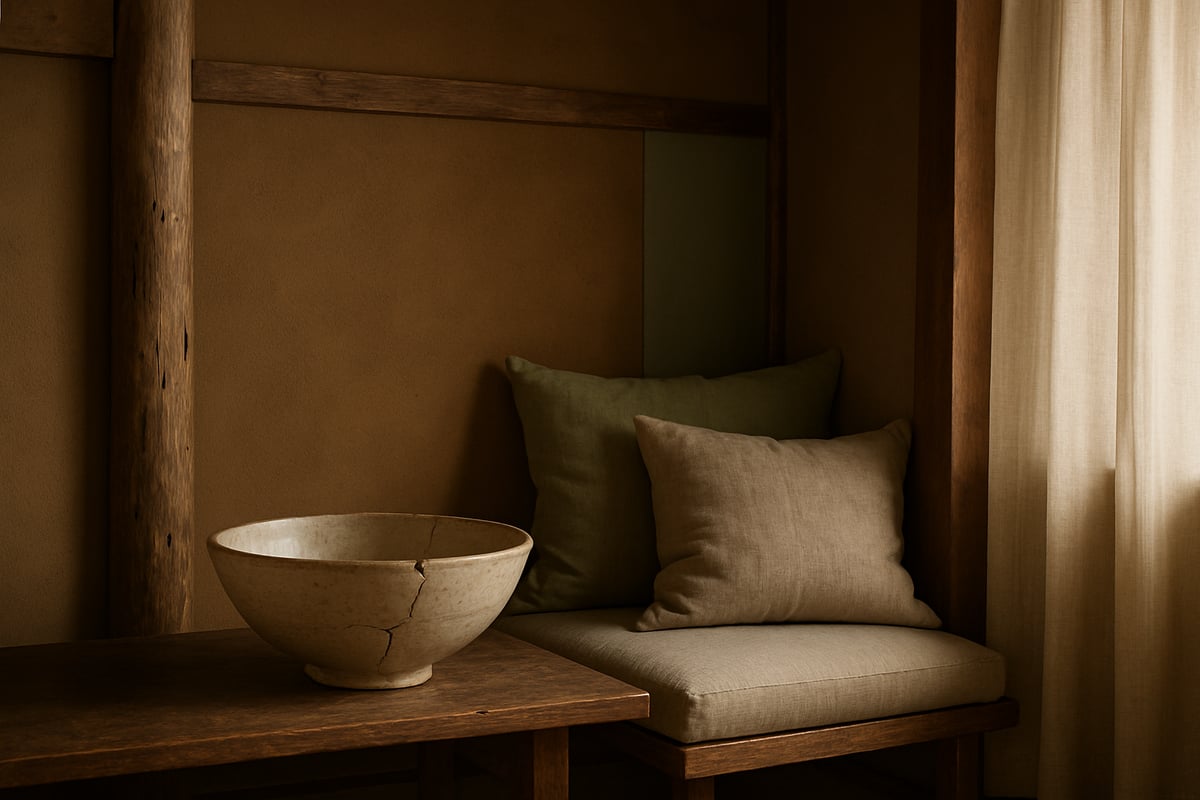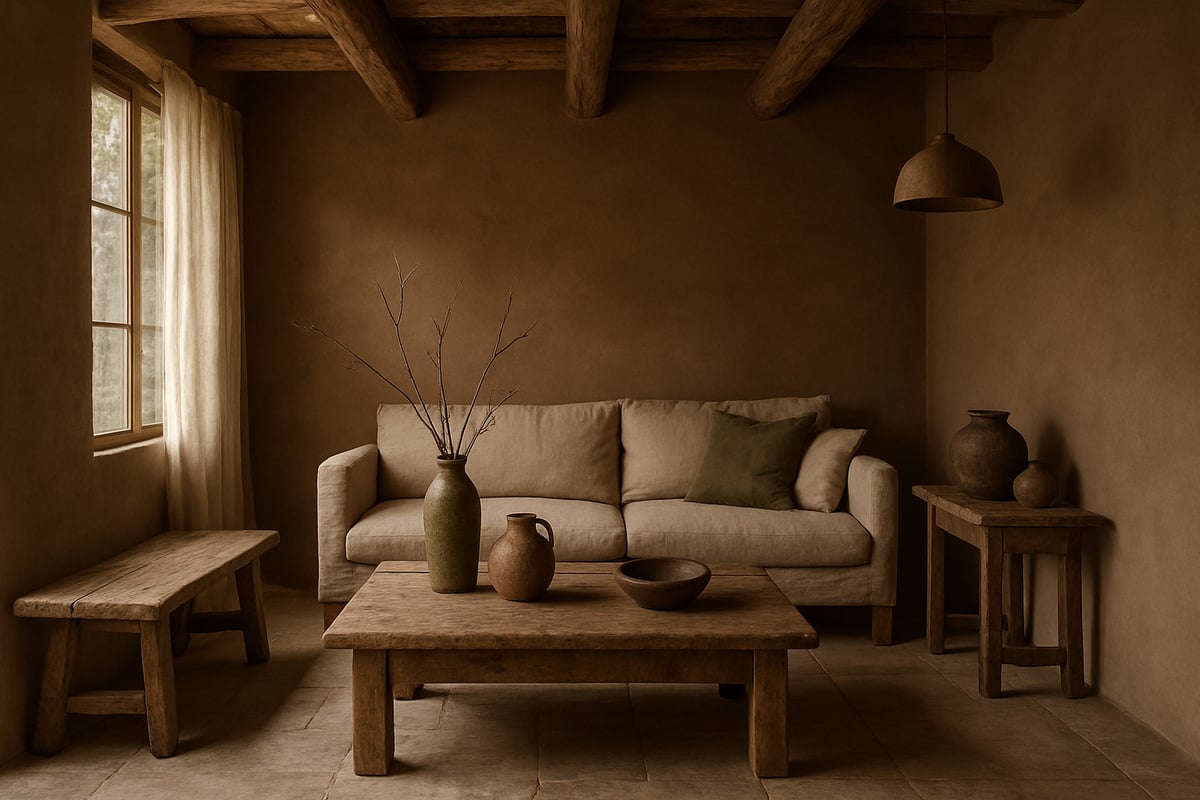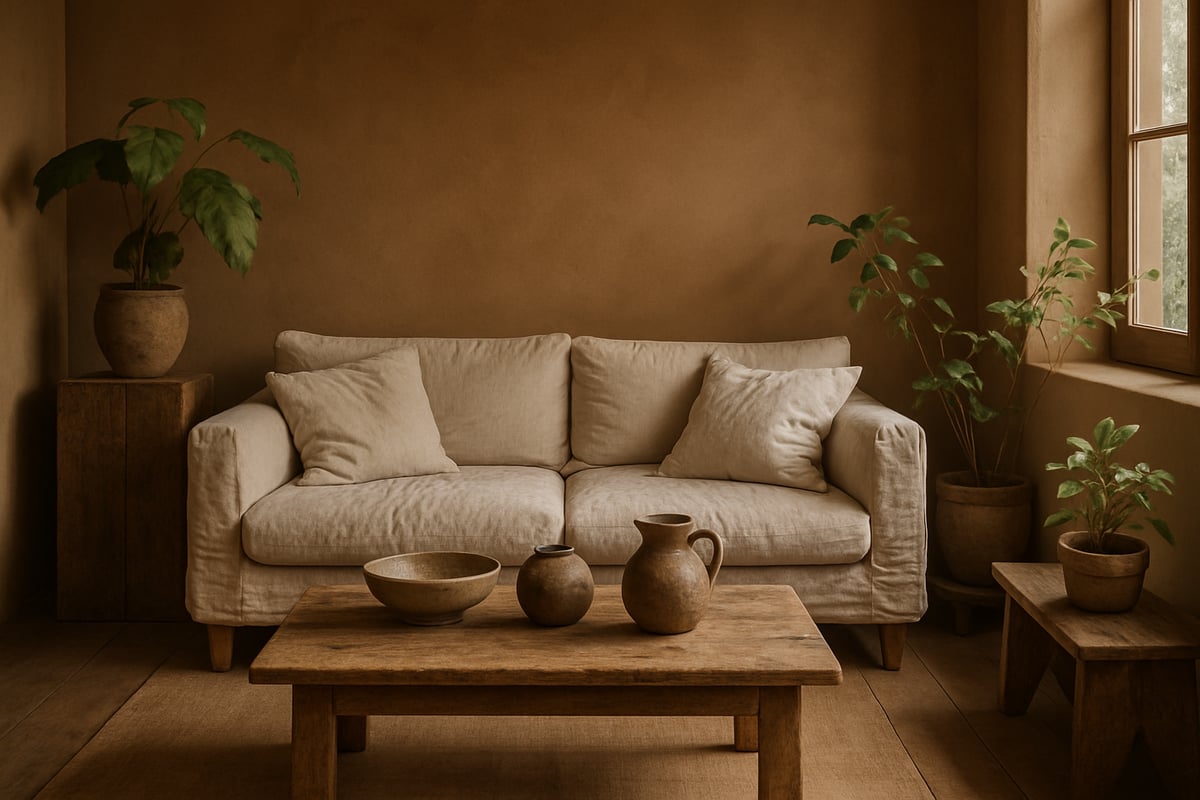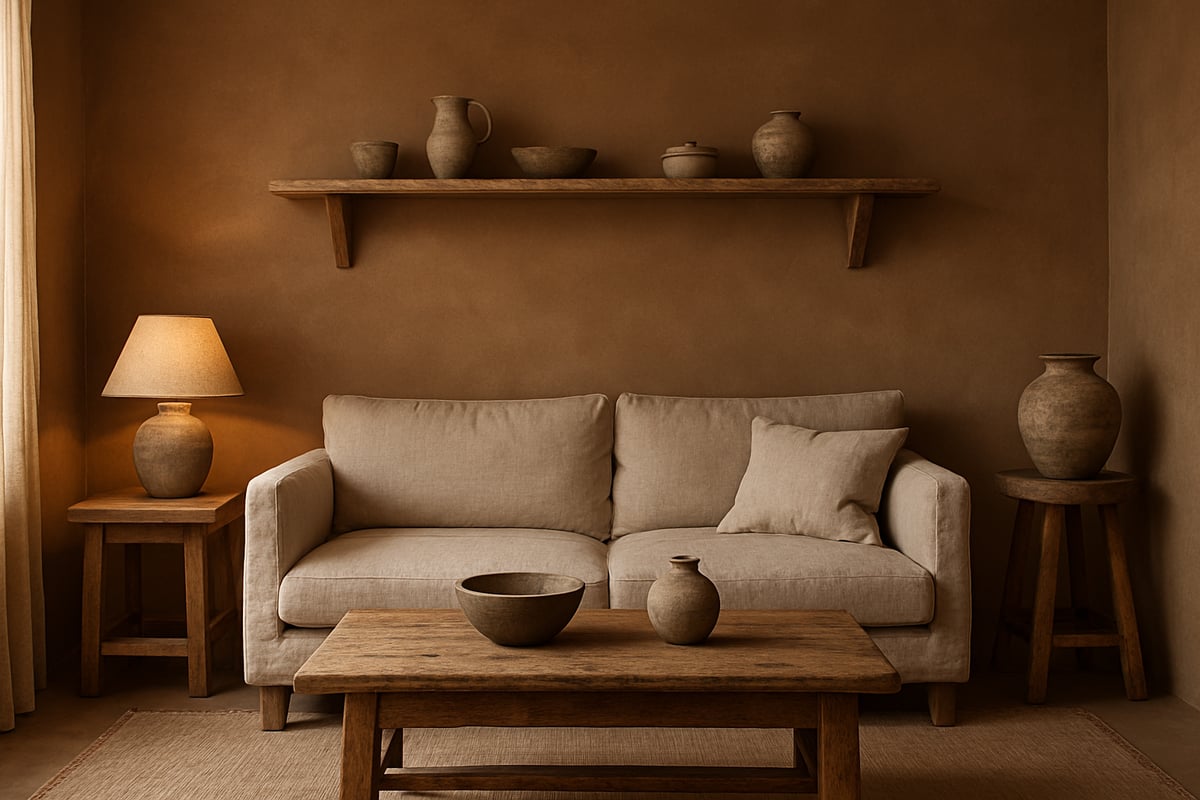Step into the world of interior design wabi sabi and discover why this serene, timeless style is making waves in 2025. As more people seek calm, authenticity, and simplicity at home, interior design wabi sabi offers a refreshing alternative to perfection and clutter.
This guide will show you how to embrace wabi sabi’s principles to create spaces that celebrate imperfection, tranquility, and natural beauty. You will explore its rich origins, core philosophy, and essential design elements.
Ready to transform your home? Learn practical steps, expert insights, and room-by-room tips to infuse tranquility and authenticity into every corner.
The Essence of Wabi Sabi: Origins and Philosophy
Wabi Sabi is more than a style—it is a philosophy that invites us to slow down and appreciate life’s quiet moments. In the context of interior design wabi sabi, this approach is deeply rooted in centuries-old traditions yet feels more relevant than ever for 2025. Why does this concept resonate so strongly, and how did it evolve into a global design movement?

Understanding Wabi Sabi’s Roots
At its core, Wabi Sabi is a union of two Japanese words, each carrying profound meaning:
- Wabi reflects rustic simplicity, humility, and a deep connection to the natural world.
- Sabi celebrates the beauty found in the passage of time, embracing impermanence and the patina of age.
This philosophy traces back to 16th-century Japanese tea ceremonies, where simplicity and authenticity were valued over ostentation. Influential tea master Sen no Rikyu played a pivotal role in shaping these ideals, favoring natural, unadorned materials and the quiet elegance of handmade objects.
Wabi Sabi’s roots are intertwined with Zen Buddhism, which teaches acceptance of imperfection and the transient nature of all things. In interior design wabi sabi, these concepts manifest as spaces that welcome wear, asymmetry, and the marks of time. For example, the gentle sheen of an old wooden table or the uneven glaze on a clay teacup becomes a symbol of life’s beauty.
Today, Wabi Sabi is recognized globally as a guiding principle for serene living. According to 2025 trend reports from Homio Decor and The Spruce, interest in Wabi Sabi has surged as more people seek authenticity and tranquility at home. For a deeper look at how this timeless philosophy is shaping current trends, explore Wabi-Sabi Interior Design Trends 2025.
Wabi Sabi in Modern Interior Design
How does interior design wabi sabi translate into contemporary homes? It stands in gentle contrast to Western ideals that often prioritize perfection, symmetry, and newness. Instead, Wabi Sabi encourages us to find comfort in simplicity and to honor the unique history of every object.
In a world that feels increasingly fast-paced and cluttered, interior design wabi sabi offers a welcome antidote. Minimalism is central, but not in a sterile sense. Each item is chosen with intention, telling a story through visible repairs, organic textures, and the subtle interplay of light and shadow.
Experts like Marie Kondo and Karin Sun highlight the importance of mindful selection and placement. Kondo’s philosophy of keeping only what sparks joy aligns closely with Wabi Sabi’s call for purposeful living. Similarly, Sun advocates for relaxed, tactile materials that invite touch and foster comfort.
Ultimately, interior design wabi sabi reminds us that authenticity and imperfection are not flaws but assets. By embracing these principles, we create spaces that nurture calm and reflect the true essence of home.
Key Elements of Wabi Sabi Interiors
Step into the world of interior design wabi sabi, where tranquility and authenticity reign. The key elements of this style invite you to slow down, appreciate the imperfect, and create spaces that feel both grounded and inspiring. Let us explore the essential features that define a wabi sabi home.

Embracing Imperfection and Authenticity
At the heart of interior design wabi sabi is the celebration of imperfection and authenticity. This approach values materials that tell a story, such as weathered wood, stone, clay, and linen. These organic elements bring warmth and depth, each with its own unique grain, texture, or mark of time.
Handmade and vintage items are preferred over mass-produced decor. A chipped ceramic bowl, a table with visible repairs, or a hand-thrown vase with uneven glaze—all are cherished as symbols of life’s natural progression. The Japanese art of kintsugi, where cracked pottery is repaired with gold, perfectly illustrates how flaws are not hidden but highlighted as part of an object’s beauty.
Wabi sabi interiors rely on a neutral, earthy color palette. Think shades of beige, taupe, soft gray, and muted greens—tones inspired by nature’s calm and subtlety. This palette sets a soothing foundation, allowing the textures and forms of each piece to stand out.
Minimalism plays a vital role. Every object is chosen intentionally, either for its function or the story it carries. Instead of clutter, there is thoughtful curation, resulting in welcoming, lived-in spaces. According to The Spruce, 68% of homeowners in 2024 prioritized sustainable, natural materials—an indicator of the growing appeal of authenticity and imperfection.
To further explore the foundational elements of this style, see this Wabi-Sabi Interior Design Essentials for 2025 guide, which outlines practical ways to incorporate these principles into your home.
Authenticity in interior design wabi sabi is not about neglect, but about honoring the unique journey of every object. A cracked bowl displayed as art or a reclaimed wood bench marks a space with character and soul.
Simplicity and Mindful Space Planning
Simplicity is another cornerstone of interior design wabi sabi. The philosophy is clear: everything has a place and a purpose. Clutter is minimized, leaving behind open layouts that encourage movement and peace.
Negative space is used intentionally. Instead of filling every corner, wabi sabi interiors allow room for light, shadow, and air to shape the atmosphere. This openness fosters tranquility and gives each item the space to be appreciated fully.
Lighting is soft and layered. Natural light is maximized, while lamps and candles add warmth and gentle highlights. The interplay of light and shadow brings a dynamic, ever-changing quality to the room.
Decor is sparse, but meaningful. An unadorned wooden bench, a single piece of imperfect pottery, or a carefully placed branch can serve as focal points. The focus is always on quality over quantity, with each object chosen for its story and utility.
In interior design wabi sabi, less truly is more. Every decision, from furniture placement to the choice of materials, is made with intention. This mindful approach transforms homes into sanctuaries of calm, where serenity is woven into every detail.
Step-by-Step Guide: Creating a Wabi Sabi Home in 2025
Ready to transform your space with the calming essence of interior design wabi sabi? This step-by-step guide walks you through actionable ways to infuse your home with tranquility, authenticity, and natural beauty. Each step is rooted in timeless Wabi Sabi principles and modern design wisdom, making it easy to create a home that feels both serene and deeply personal.

Step 1: Declutter and Curate with Intention
Begin your interior design wabi sabi journey by clearing away excess. Remove anything that does not serve a clear function or bring genuine joy. This process is not about creating an empty space but about making room for what truly matters.
Marie Kondo's method encourages you to keep only items that spark joy. Apply this mindset throughout your home. Open shelving can beautifully display cherished items, while hidden storage keeps visual clutter at bay.
- Keep surfaces clear, showing only meaningful objects.
- Sort items by category and donate or recycle what you no longer need.
- Store everyday essentials in woven baskets or simple boxes.
Intentional curation invites calm and clarity, setting the stage for all other steps in interior design wabi sabi.
Step 2: Choose Natural and Sustainable Materials
Material selection is central to interior design wabi sabi. Opt for elements that echo nature, such as wood, stone, clay, and linen. These materials age gracefully, developing character over time.
Seek out artisan-made or reclaimed furnishings. Let wood show its grain, and allow metals to patina. Linen bedding and woven baskets bring texture and warmth, while stone counters or clay planters ground the space.
- Prioritize eco-friendly, sustainable sources.
- Choose finishes that highlight natural imperfections.
- Mix rough and smooth textures for visual interest.
These choices ensure your home feels welcoming, honest, and rooted in the earth—a core value of interior design wabi sabi.
Step 3: Celebrate Imperfection and Uniqueness
Wabi Sabi teaches us to see beauty in flaws and individuality. In interior design wabi sabi, this means highlighting cracks, repairs, and the passage of time.
Display a cracked vase repaired with kintsugi or showcase vintage finds alongside new pieces. Seek out handmade ceramics, uneven glazes, or weathered surfaces. Each imperfection tells a story and adds soul to your home.
- Mix old and new items for layered character.
- Use mended textiles or visibly repaired pottery as focal points.
- Embrace patina on leather, wood, and metal.
By celebrating uniqueness, you create a space that is both inviting and deeply personal—a hallmark of interior design wabi sabi.
Step 4: Incorporate Nature and Biophilic Elements
Bringing nature indoors is essential in interior design wabi sabi. Houseplants, dried branches, stones, and shells can soften lines and connect your home to the outdoors. Arrange these elements asymmetrically, reflecting the spontaneity of the natural world.
Natural light is just as important. Keep windows unobstructed to let sunlight and shadow play across your rooms. Layering greenery with organic textures, like wicker or clay, adds depth and calm.
- Use plants to purify air and add softness.
- Place stones or driftwood as natural sculptures.
- Let light and shadow create changing moods.
For more inspiration on integrating biophilic elements, explore Biophilic design inspiration. These touches reinforce the serenity at the heart of interior design wabi sabi.
Step 5: Layer Textures and Warm Neutrals
Texture brings dimension and comfort to interior design wabi sabi. Combine rough and smooth surfaces—think raw wood, tactile linen, and soft wool. Stick to a palette of earthy neutrals: beige, taupe, muted greens, and grays.
Layering textiles, such as washed linen bedding or handmade rugs, creates a lived-in feel. Karin Sun recommends relaxed, wrinkled linens for both comfort and authenticity.
- Add wool throws or handwoven pillows.
- Use textured ceramics for visual interest.
- Pair soft fabrics with rustic surfaces.
This approach fosters warmth and ease, inviting you to relax and unwind—a central goal in interior design wabi sabi.
Step 6: Personalize with Meaningful Objects
Personal touches are the soul of interior design wabi sabi. Decorate with items that tell your story, such as family heirlooms, children’s art, or travel finds. Each object should evoke emotion or memory, not just fill space.
Choose hand-spun vases, vintage photographs, or hand-carved bowls. Display these treasures thoughtfully, allowing them to breathe within the room.
- Rotate objects seasonally for fresh inspiration.
- Group items by theme or sentiment.
- Avoid over-decorating; let each piece stand out.
Personalization ensures your home reflects your journey, infusing it with authenticity and depth—the essence of interior design wabi sabi.
Step 7: Let Spaces Evolve Over Time
Interior design wabi sabi is not about creating a picture-perfect home. Instead, allow your spaces to change and grow. Let leather chairs develop a patina, and appreciate the wear on wooden floors. Rotate decor and furniture as your needs shift or as seasons change.
Avoid striving for a “finished” look. Embrace ongoing transformation, knowing that each mark or change adds richness to your home’s story.
- Rearrange furniture to suit new routines.
- Welcome the marks left by daily life.
- See beauty in aging and adaptation.
For more insights and inspiration on embracing imperfection throughout your home, visit the Wabi Sabi interiors guide. Let your home be a living canvas, always evolving with you—a foundational principle of interior design wabi sabi.
Room-by-Room Wabi Sabi Design Strategies
Transforming your home with interior design wabi sabi principles is most effective when approached one room at a time. Each space offers unique opportunities to express tranquility, embrace imperfection, and create a calming environment. Let’s explore practical strategies for infusing Wabi Sabi into every room, ensuring your home feels cohesive, authentic, and welcoming.

Living Room: Calm, Cozy, and Connected
The living room is the heart of interior design wabi sabi, where comfort and connection thrive. Begin with an open, uncluttered layout that invites movement and relaxation. Choose low, natural seating like wooden benches or linen sofas to encourage groundedness.
- Select neutral, earthy tones for walls and textiles
- Layer soft lighting using lamps and candles to create warmth
- Display handmade or imperfect pottery as focal points
- Incorporate cozy wool throws and textured pillows
A well-designed living room balances negative space with meaningful objects. For instance, a neutral-toned sofa paired with a rough-hewn wooden coffee table showcases the beauty of natural materials. According to Homio Decor, 74% of designers recommend maximizing natural light in Wabi Sabi spaces, which further enhances tranquility.
Bedroom: Sanctuary of Rest and Simplicity
Your bedroom should embody the restful spirit of interior design wabi sabi. Prioritize comfort with soft, relaxed linens and a muted color palette. Embrace imperfection by allowing bedding to remain slightly wrinkled and by mixing pillows of different textures.
- Keep surfaces clear except for a few meaningful items
- Use calming colors like soft beige, gray, or muted green
- Display a single vase of dried flowers for a touch of nature
- Integrate vintage or handmade decor for authenticity
To spark inspiration, explore Bedroom design ideas that reflect Wabi Sabi’s peaceful ethos. Remember, serenity comes from intentional simplicity. A hand-carved wooden bowl or a cherished photograph on the nightstand can infuse personal meaning into the space, making it truly your own.
Kitchen & Dining: Warmth and Gathering
In the kitchen and dining area, interior design wabi sabi shines through the celebration of daily rituals and communal warmth. Open shelving keeps the atmosphere light, while curated dishware adds visual interest.
- Use handmade ceramics and wooden utensils
- Allow surfaces to show use, such as patina on cutting boards
- Feature cracked or mended bowls as conversation pieces
- Opt for natural stone countertops and simple, functional layouts
Let the kitchen tell its story through visible wear and time-earned character. The combination of artisan ceramics and rustic wood brings a sense of lived-in comfort, turning everyday meals into mindful experiences.
Bathroom: Spa-Like Serenity
A Wabi Sabi bathroom offers a quiet retreat from the world. Focus on organic materials and a restrained palette to evoke a spa-like atmosphere.
- Incorporate stone sinks, wooden stools, and linen towels
- Keep products minimal and neatly arranged
- Add greenery or natural scents like eucalyptus and cedar
- Use soft, diffused lighting for relaxation
The interior design wabi sabi approach in the bathroom is about creating a space that feels both grounding and rejuvenating. Even small touches, like a single plant or a weathered soap dish, can make a significant impact.
Workspace: Focus and Inspiration
A workspace designed with interior design wabi sabi principles fosters both focus and creativity. Keep the desk area uncluttered, allowing natural light to fill the space.
- Choose simple, inspiring objects like a handmade pen holder
- Display a single ceramic mug or a small plant for calm
- Emphasize negative space to prevent distraction
- Use neutral tones and tactile materials for comfort
By limiting decor to a few meaningful pieces, the workspace remains functional yet inspiring. This intentional design approach helps reduce mental clutter, supporting productivity and well-being.
Expert Insights: Wabi Sabi in Practice for 2025
Discover how interior design wabi sabi comes to life through the wisdom of leading designers and the latest 2025 trends. Drawing from the expertise of Marie Kondo, Karin Sun, and Rowena Lei, this section explores actionable strategies for embracing imperfection, intentionality, and authenticity in your space. Their insights offer a roadmap for transforming any home into a tranquil haven that reflects your story.
Marie Kondo: Intentional Living
Marie Kondo’s philosophy is deeply aligned with interior design wabi sabi. She encourages homeowners to be mindful and deliberate about every object they keep, suggesting that true tranquility comes from surrounding yourself only with possessions that “spark joy.” This approach is about more than decluttering, it is about creating space for what matters.
Kondo’s practice involves a regular ritual of reviewing items, letting go of those that no longer serve a purpose, and organizing what remains with care. For those interested in interior design wabi sabi, her advice underscores the importance of intentional selection and placement. Each item should support a sense of peace and authenticity, reflecting both utility and personal meaning.
- Regularly assess your belongings.
- Value function and emotional resonance.
- Arrange objects thoughtfully to promote calm.
Kondo’s intentionality transforms interiors into restorative retreats.
Karin Sun: Comfort in Imperfection
Karin Sun’s approach to interior design wabi sabi focuses on comfort and the beauty of imperfection. She champions relaxed textiles, such as washed linen and handwoven throws, that invite touch and create a welcoming, lived-in atmosphere. Sun believes that rooms should be comfortable, not staged, and that embracing flaws adds genuine character.
She recommends choosing materials that age gracefully, such as wool, cotton, and wood, allowing natural wear and patina to become part of the story. Sun also encourages the use of neutral, earthy palettes to foster serenity, suggesting that the right texture can evoke a sense of groundedness.
- Incorporate tactile materials like linen and wool.
- Choose pieces that feel inviting rather than pristine.
- Accept wrinkles, mismatched items, and visible repairs.
For Sun, the essence of interior design wabi sabi is found in the details and the stories they tell.
Rowena Lei: Aging Gracefully
Rowena Lei brings a unique perspective to interior design wabi sabi by valuing objects that develop character over time. She advises investing in quality, timeless pieces that are meant to be used, loved, and allowed to age. Lei suggests mixing old and new elements to create a layered, authentic environment.
Her philosophy emphasizes that patina, scratches, and wear are not imperfections to be hidden but features to be celebrated. In Lei’s view, a leather chair that grows softer or wooden floors that show years of footsteps contribute to a sense of history and belonging.
- Invest in durable, well-crafted furniture.
- Combine vintage finds with contemporary items.
- Let materials evolve naturally with daily use.
This approach ensures that your interior design wabi sabi remains dynamic and personal, growing richer with time.
Data & Trends for 2025
In 2025, interior design wabi sabi is at the forefront of global trends. Reports from Homio Decor and The Spruce reveal that 60% of surveyed homeowners seek calming, authentic spaces. There is a surging demand for sustainable and artisan-made decor, reflecting a collective move toward mindful living and away from mass-produced perfection.
Practical Examples from Real Homes
Real-world applications of interior design wabi sabi abound. Urban apartments are being transformed with open shelving, vintage finds, and neutral palettes. Suburban homes are embracing clutter-free layouts, patinaed wood, and imperfect ceramics. For more expert opinions and inspiring case studies, explore Embracing Imperfection in 2025 Interiors.
Common challenges include letting go of the need for perfection and sourcing natural materials. The key is to experiment, stay intentional, and let your space evolve as a true reflection of your life.
Tips and Common Mistakes to Avoid in Wabi Sabi Interiors
Creating a tranquil home with interior design wabi sabi is rewarding, but it requires a mindful approach. The beauty of this style lies in its simplicity and authenticity, yet many overlook key principles or fall into common traps. To help you achieve a harmonious Wabi Sabi space, consider these practical tips and avoidable mistakes.
Essential Tips for Interior Design Wabi Sabi:
- Start small by focusing on one room or even a single corner. Gradual change helps you understand what feels right.
- Invest in quality rather than quantity. Choose artisan, handmade, or vintage items that tell a story. For inspiration, browse the Wabi Sabi furniture collection to find authentic pieces that embody these principles.
- Mix textures and natural materials for visual interest and comfort.
- Embrace the aged, imperfect, and unique. Let go of the need for everything to look new or flawless.
- Allow your space to evolve naturally over time, rather than aiming for a finished look.
Common Mistakes to Avoid:
- Confusing interior design wabi sabi with neglect or shabbiness. Wabi Sabi is about intentional beauty, not disorder.
- Over-cluttering with rustic or vintage items. Maintain clear surfaces and thoughtful placement.
- Using synthetic or mass-produced materials. Opt for authentic, sustainable choices whenever possible.
- Ignoring personal meaning. Your home should reflect your life story and values, not just a trend.
Real-Life Example:
Imagine a cluttered living room transformed by removing excess decor, displaying a single hand-carved wooden bowl, and letting natural light flow in. Before-and-after photos show a shift from chaos to calm. According to The Spruce, 80% of people report increased calm after simplifying their living spaces.
By following these tips and being mindful of common pitfalls, you can let interior design wabi sabi bring genuine tranquility and authenticity to your home.
Resources and Inspiration for Your Wabi Sabi Journey
Embarking on your interior design wabi sabi journey means gathering the right inspiration and tools. Whether you are a seasoned designer or a newcomer, these resources will help you deepen your understanding and bring tranquility into your spaces.
Books & Reading List
Expand your knowledge of interior design wabi sabi with essential books. “Wabi-Sabi: for Artists, Designers, Poets & Philosophers” by Leonard Koren is a foundational read, offering deep insights into the philosophy behind the style. Other titles such as “Wabi Sabi: The Japanese Art of Impermanence” by Andrew Juniper provide practical perspectives for modern living.
Digital Inspiration: Social Media & Blogs
For daily inspiration, follow top Instagram accounts and design blogs specializing in interior design wabi sabi. Visual platforms showcase real homes, curated vignettes, and styling tips. For a deeper dive into trends and the fusion of wabi sabi with nature-inspired elements, explore resources like Wabi-Sabi and Biophilic Design in 2025, which highlights how serenity and authenticity shape current interiors.
Courses, Workshops & Where to Shop
Enhance your interior design wabi sabi skills through online courses and workshops. Many design schools and artisan studios offer classes on mindful styling and sustainable materials. For unique decor, visit local markets, vintage shops, and online platforms specializing in artisan-made pieces. Seek out handmade ceramics, natural linens, and reclaimed wood furniture to create a truly personal space.
Notable Designers & Real Projects
Look to renowned designers and studios who champion interior design wabi sabi in their work. Publications like Homio Decor and The Spruce often feature real-life projects, offering practical ideas and visual examples. Studying these spaces helps you see how wabi sabi principles are adapted to various lifestyles and environments.
Personalize your interior design wabi sabi approach, experiment with new ideas, and let your home evolve naturally. Remember, the most inspiring spaces reflect your unique story and embrace beauty in imperfection.
As you explore the calming philosophy and timeless elegance of Wabi Sabi interiors, you might feel inspired to bring these principles into your own home. Whether you are new to design or looking to deepen your skills, taking the next step can make a real difference in how you shape your living spaces. If you’re ready to move from inspiration to action, you can build a strong foundation in practical design strategies that embrace authenticity, simplicity, and personal meaning. Let’s start this creative journey together—Get started with Interior Design and transform your space into a sanctuary of tranquility.





Share:
online sofa design guide 2025
9 Essential Interior Design Styles - Ideas for 2025